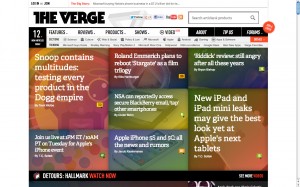As I am getting closer and closer to having a blog of my own, I must keep in mind what people want to read in a blog and what keeps web users engaged.
With the help of Brian Carroll, I have come up with a four qualities to give an idea of what makes a quality blog.: Interactive, quirky, thoughtful design, and consistent.
1: Interactive: Brian Carroll emphasizes that an interactive blog is much more attractive than one with nothing but blocks of text. Embedded videos, free mp3 downloads, big eye-catching links to relevant content, and GIFs are what pique the interest of your everyday web user, not text alone. For example, “What Should We Call Me” is a Tumblr blog that generated thousands of followers with Gifs as its only content. Scrolling through blogs like Buzzfeed will provide a perfect example of interactivity. With a clear and attractive menu of yellow buttons that say “LOL” “OMG” and “cute”, users know exactly what content they can access when they click.
2: Quirky: While the adjective “quirky” can be confusing, I believe it sums up a lot of the concepts the book defines as “good blog” criteria. People love quirky things. Personally, I am more drawn to blogs about something unique and interesting than a generic gossip site. Jezebel is a perfect example of the quirky appeal. The author combines humor, personal stories, and relatable realness that makes it quirky. Also, Zooey Deschanel’s blog, Hello Giggles, is possibly the epitome of quirky. Even if the blog wasn’t run by a celebrity, Hello Giggles can stand on its own because of its unique content and broad appeal. Its quirkiness comes from the combining of DIY craft projects with recipes and fashion and beauty advice. Hearing it all from a relatable and endearing voice is a combination that keeps readers coming back for more.
3: Design: In agreement with Brian Carroll, dominant headlines will immediately draw a web user in. Looking at blogs such as Buzzfeed, Betches Love This, and Gawker, the headline is a staple into grabbing the attention of a reader. As a blog surfer myself, I can attest that if the title doesn’t grab my attention, I will be less inclined to read the content. General layout should be easy to navigate with lots of content to explore. On Tumblr blogs, the endless scrolling of pictures makes it so easy for a viewer to stay on the page for hours with new content appearing without even needing to click.
4: Consistent: Consistence is key. People want to see more of what makes a blog stand out. Keeping a blog up to date with relevant, exciting content is imperative in keeping the attention of viewers.









